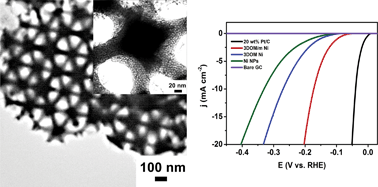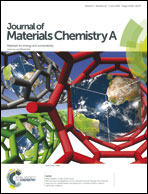Three-dimensionally ordered macro-/mesoporous Ni as a highly efficient electrocatalyst for the hydrogen evolution reaction†
Abstract
Three-dimensionally (3D) ordered macro-/mesoporous (3DOM/m) Ni is fabricated by the chemical reduction deposition method using lyotropic liquid crystals (LLC) to template the mesostructure within the regular voids of a colloidal crystal (opal). The thereby achieved structural advantages of combining well-ordered bicontinuous mesopores with 3D interconnected periodic macropores, such as abundant exposed catalytically active sites, efficient mass transport, and high electrical conductivity, make this non-noble metal structure an excellent hydrogen evolution reaction (HER) electrocatalyst. The 3DOM/m Ni exhibits a low onset overpotential of 63 mV (vs. RHE) and a small Tafel slope of 52 mV per decade, as well as a long-term durability in alkaline medium. These distinct features of the 3DOM/m Ni render it a promising alternative to Pt-based HER electrocatalysts.



 Please wait while we load your content...
Please wait while we load your content...